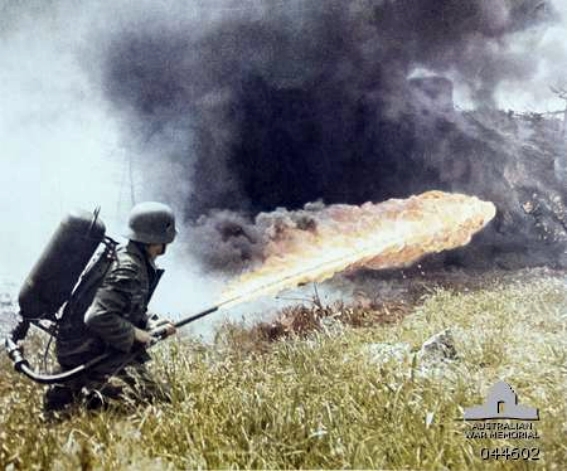If you have a serious penchant for expressing your personal freedoms through weapons a revolver or automatic sniper rifle may still not be enough. So, you should throw out that rusty AK47 and the grenade launcher — no doubt stashed only for “critter hunting” — and consider some really serious heat, literally. Imagine your very own personal flamethrower!
While flamethrowers are banned for national and military use by the Inhumane Weapons Convention, to which the United States is a signatory, personal use is more loosely regulated. In the United States some states have banned flamethrowers completely, while others like California, require only a permit. There is now a growing effort to regulate flamethrowers at a national level, and more tightly. So, you may well want to procure one very soon, before those freedom-hating feds limit access to yet another form of seriously hot macho pleasure.
From ars technica:
In the wake of two companies now selling the first commercially available flamethrowers in the United States, at least one mayor has called for increased restrictions on their use. And to no one’s surprise, the prospect of prohibition has now driven more sales.
“Business is skyrocketing higher than ever due to the discussion on prohibition,” Chris Byars, the CEO of the Ion Productions Team based in Troy, Michigan, told Ars by e-mail. “I’m a huge supporter of personal freedom and personal responsibility. Own whatever you like, unless you use it in a manner that is harmful to another or other’s property. We’ve received a large amount of support from police, fire, our customers, and interested parties regarding keeping them legal.”
Byars added that the company has sold 350 units at $900 each, including shipping, in recent weeks. That’s in addition to the $150,000 the company raised on IndieGoGo.
The Ion product, known as the XM42, can shoot fire over 25 feet and has more than 35 seconds of burn time per tank of fuel. With a full tank of fuel, it weighs just 10 pounds.
Another company—XMatter, based in Cleveland, Ohio—sells a similar device for $1,600 each, but it weighs 50 pounds. However, this device has approximately double the range of the XM42. Quinn Whitehead, the company’s co-founder, did not immediately respond to Ars’ request for comment.
Last week, Mayor Jim Fouts of nearby Warren, Michigan—the third largest city in the state—told Ars that he was worried about the sale of such devices in his city.
“My concern is that flamethrowers in the wrong hands could cause catastrophic damage either to the person who is using it or more likely to the person who is being targeted,” he said. “This is a pretty dangerous mix because it’s a combination of butane and gasoline which is highly flammable. Anybody who aims this at someone else or something happens and it happens close to them is going to be close to be incinerated.”
…
Shockingly, there are no current federal regulations on the possession, manufacture, sale, or use of flamethrowers.
“These devices are not regulated as they do not qualify as firearms under the National Firearms Act,” Corey Ray, a spokesman with the Bureau of Alcohol, Tobacco, and Firearms, told Ars by e-mail.
At the state level, California requires a permit while Maryland outright bans them—Ars is not aware of any other state-level regulation. The Inhumane Weapons Convention, which the United States signed in 1981, forbids “incendiary weapons,” including flamethrowers. However, this document is only an agreement between nation-states and their militaries, and it did not foresee individual possession.
A new bill in Troy, Michigan, proposed earlier this month would forbid “storage, use, and possession of flamethrowers in the city.” Violations of the law would constitute a misdemeanor punishable by up to 90 days in jail, a $500 fine, or both in addition to seizure of the device.
Read the entire story here.
Image: German soldier with flame-thrower c.1941. Public Domain. Courtesy of Wikipedia.



 You might expect to find police drones in the pages of a science fiction novel by Philip K. Dick or Iain M. Banks. But by 2015, citizens of the United States may well see these unmanned flying machines patrolling the skies over the homeland. The U.S. government recently pledged to loosen Federal Aviation Administration (FAA) restrictions that would allow local law enforcement agencies to use drones in just a few short years. So, soon the least of your worries will be traffic signal cameras and the local police officer armed with a radar gun. Our home-grown drones are likely to be deployed first for surveillance. But, undoubtedly armaments will follow. Hellfire missiles over Helena, Montana anyone?
You might expect to find police drones in the pages of a science fiction novel by Philip K. Dick or Iain M. Banks. But by 2015, citizens of the United States may well see these unmanned flying machines patrolling the skies over the homeland. The U.S. government recently pledged to loosen Federal Aviation Administration (FAA) restrictions that would allow local law enforcement agencies to use drones in just a few short years. So, soon the least of your worries will be traffic signal cameras and the local police officer armed with a radar gun. Our home-grown drones are likely to be deployed first for surveillance. But, undoubtedly armaments will follow. Hellfire missiles over Helena, Montana anyone?